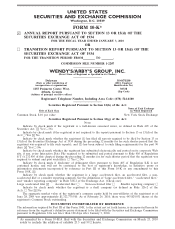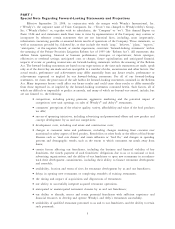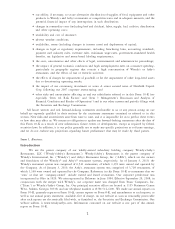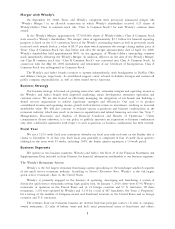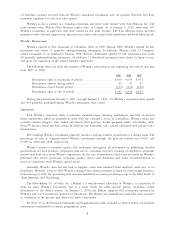Wendy's 2009 Annual Report Download - page 17
Download and view the complete annual report
Please find page 17 of the 2009 Wendy's annual report below. You can navigate through the pages in the report by either clicking on the pages listed below, or by using the keyword search tool below to find specific information within the annual report.Competition
Arby’s faces direct and indirect competition from numerous well-established competitors, including
national and regional non-burger sandwich chains, such as Panera Bread, Subwayand Quiznos, as well as
hamburger chains, such as McDonald’s, Burger Kingand Wendy’s, and other quick service restaurant
chains, such as Taco Bell, Chick-Fil-Aand Kentucky Fried Chicken. In addition, Arby’s competes with
locally owned restaurants, drive-ins, diners and other similar establishments. Key competitive factors in the
quick service restaurant industry are price, quality of products, convenience, quality and speed of service,
advertising, brand awareness, restaurant location and attractiveness of facilities. Arby’s also competes within the
food service industry and the quick service restaurant sector not only for customers, but also for personnel,
suitable real estate sites and qualified franchisees.
Many of the leading restaurant chains have focused on new unit development as one strategy to increase
market share through increased consumer awareness and convenience. This has led to increased competition for
available development sites and higher development costs for those sites, although the recent decline in
commercial real estate values has somewhat offset those costs. Competitors also employ marketing strategies
such as frequent use of price discounting, frequent promotions and heavy advertising expenditures. Continued
price discounting in the quick service restaurant industry and the emphasis on value menus has had and could
continue to have an adverse impact on Arby’s. In addition, the growth of fast casual chains and other in-line
competitors could cause some fast food customers to “trade up” to a more traditional dining out experience
while keeping the benefits of quick service dining.
Other restaurant chains have also competed by offering high quality sandwiches made with fresh
ingredients and artisan breads. Several chains have also sought to compete by targeting certain consumer
groups, such as capitalizing on trends toward certain types of diets (e.g., low carbohydrate or low trans fat) by
offering menu items that are promoted as being consistent with such diets.
Additional competitive pressures for prepared food purchases come from operators outside the restaurant
industry. A number of major grocery chains offer fresh deli sandwiches and fully prepared food and meals to go
as part of their deli sections. Some of these chains also have in-store cafes with service counters and tables
where consumers can order and consume a full menu of items prepared especially for that portion of the
operation. Additionally, convenience stores and retail outlets at gas stations frequently offer sandwiches and
other foods.
Quality Assurance
ARG has developed a quality assurance program designed to maintain standards and the uniformity of
menu offerings at all Arby’s restaurants. ARG assigns a quality assurance employee to each of the independent
facilities that process beef for domestic Arby’s restaurants. The quality assurance employee inspects the beef for
quality, uniformity and to assure compliance with quality and safety requirements of the USDA and the FDA.
In addition, ARG periodically evaluates randomly selected samples of beef and other products from its supply
chain. Each year, ARG representatives conduct unannounced inspections of operations of a number of
franchisees to ensure that required policies, practices and procedures are being followed. ARG field
representatives also provide a variety of on-site consulting services to franchisees. ARG has the right to
terminate franchise agreements if franchisees fail to comply with quality standards.
Acquisitions and Dispositions of Arby’s Restaurants
Arby’s has from time to time acquired the interests of and sold Arby’s restaurants to franchisees, and it is
anticipated that the company may have opportunities for such transactions in the future. Arby’s will continue
to sell and acquire restaurants in the future where prudent.
International Operations
As of January 3, 2010, Arby’s had 122 franchised restaurants in Canada and 3 other countries. Arby’s is
evaluating further expansion into other international markets. Arby’s has granted development rights in
Canada. In addition, Arby’s has granted development rights for dual-branded Wendy’s and Arby’s restaurants
in 12 countries in the Middle East and North Africa.
Our market entry strategy and terms for the development and operation of Arby’s restaurants in markets
outside of the United States and Canada vary depending upon market conditions.
10


